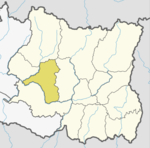Baksila is a village and village development committee in Khotang District in the Sagarmatha Zone of eastern Nepal. At the time of the 1991 Nepal census it had a population of 3,996 persons living in 796 individual households. Baksila is a five hours walk from Diktel, headquarters of Khotang District. Surrounded by Baspani, Sungdel, Dipsung, Rakha Saptewor and Kharmi, the village is split into nine wards geographically. It became the headquarters of Kepilasgadhi rural municipality after the local level division in line with the constitution and local level election. It is ward number 4 of Kepilasgadhi RM and Ganesh Bahadur Adhikari is the chairperson of ward. Shree Prithvi Higher Secondary School, Local Buddha Bajar, Kepilasgadhi, etc. are the main places/offices.
Chisapani is a town and Village Development Committee in Khotang District in the Sagarmatha Zone of eastern Nepal. At the time of the 1991 Nepal census it had a population of 4,276 persons living in 791 individual households.
Dandagaun is a village and Village Development Committee in Khotang District in the Sagarmatha Zone of eastern Nepal. At the time of the 1991 Nepal census it had a population of 2,903 persons living in 528 individual households.
Dhitung is a village and Village Development Committee in Khotang District in the Sagarmatha Zone of eastern Nepal. At the time of the 1991 Nepal census it had a population of 3,009.
Diplung is a village and Village Development Committee in Khotang District in the Sagarmatha Zone of eastern Nepal. At the time of the 1991 Nepal census it had a population of 2,063 persons living in 399 individual households.
Indrayani Pokhari is a town and Village Development Committee in Khotang District in the Sagarmatha Zone of eastern Nepal. At the time of the 1991 Nepal census it had a population of 3,589 persons living in 697 individual households.
Jyamire is a village and Village Development Committee in Khotang District in the Sagarmatha Zone of eastern Nepal. At the time of the 1991 Nepal census it had a population of 1,579 persons living in 298 individual households.
Kaule is a village and Village Development Committee in Khotang District in the Sagarmatha Zone of eastern Nepal. At the time of the 1991 Nepal census it had a population of 2,035 persons living in 373 individual households.
Kharpa is a village and Village Development Committee in Khotang District in the Sagarmatha Zone of eastern Nepal. At the time of the 1991 Nepal census it had a population of 2,096 living in 393 individual households.
Khotang Bazar is a village and Village Development Committee in Khotang District in Province No. 1 in eastern Nepal. At the time of the 1991 Nepal census, it had a population of 2,433 persons living in 458 individual households.....
Kubhinde is a village and Village Development Committee in Khotang District in the Sagarmatha Zone of eastern Nepal. At the time of the 1991 Nepal census it had a population of 2,189 persons living in 406 individual households.
Makpa is a village and Village Development Committee in Khotang District in the Sagarmatha Zone of eastern Nepal. At the time of the 1991 Nepal census it had a population of 2,238.
Mauwabote is a village and Village Development Committee in Khotang District in the Sagarmatha Zone of eastern Nepal. At the time of the 1991 Nepal census it had a population of 1,484 persons living in 259 individual households.
Nerpa is a town and Village Development Committee in Khotang District in the Sagarmatha Zone of eastern Nepal. At the time of the 1991 Nepal census it had a population of 3,481 persons living in 625 individual households.
Pauwasera is a village and Village Development Committee in Khotang District in the Sagarmatha Zone of eastern Nepal. At the time of the 1991 Nepal census it had a population of 1,962 persons living in 315 individual households.
Phedi is a town and Village Development Committee in Khotang District in the Sagarmatha Zone of eastern Nepal. At the time of the 1991 Nepal census it had a population of 3,731 persons living in 730 individual households.
Ratancha Majhagaun is a town and Village Development Committee in Khotang District in the Sagarmatha Zone of eastern Nepal. At the time of the 1991 Nepal census it had a population of 3,176 persons living in 591 individual households.

Sungdel is a village and Village Development Committee in the Khotang District in the Sagarmatha Zone of eastern Nepal. At the time of the 1991 Nepal census it had a population of 2,846 persons living in 585 individual households. It is at the northeast belt of the Khotang district. Currently, there is a high school, Shree surya Ma. Vi, and four primary schools. People run their own hydropower. The majority of people are Koyee Rai. It is the only place where Koyee people speak their mother language, Koyee. This language is also known as Sungdele Bhasa. Most people depend on farming. The highest hill in Khotang district, Loure, is situated in Sungdel.
Wopung is a village and Village Development Committee in Khotang District in the Sagarmatha Zone of eastern Nepal. At the time of the 1991 Nepal census it had a population of 2,854 persons living in 508 individual households.
Yamkhya is a village and Village Development Committee in Khotang District in the Sagarmatha Zone of eastern Nepal. At the time of the 1991 Nepal census it had a population of 3,132 persons living in 563 individual households.

